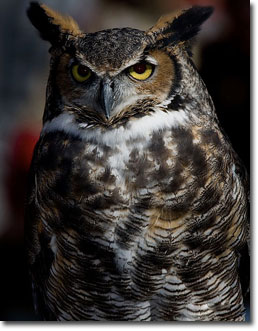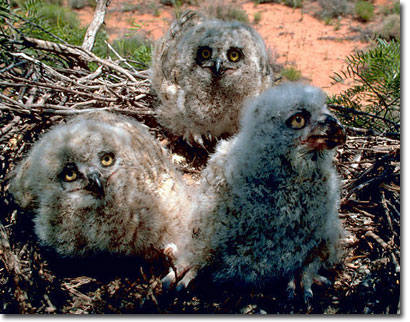Great horned Owl
(Bubo virginianus)
 Description & Range:
Description & Range:
Great horned owls are the largest of our tufted owl species in Maryland. As their name states, these birds have two prominent ear tufts also known as ‘horns’ on the sides of their head. Great horned owls are relatively thick-bodied owls that have mottled gray-brown patterns on much of their body. These owls have reddish-brown faces, a white patch on the throat and striking yellow eyes. Great horned owls can get up to 25 inches in length and can have up to a 5 foot wingspan! Juveniles are covered mostly in grayish down. Males and females have the same color patterns.
Great horned owls can be found throughout Maryland. In addition, they are the most widely distributed true owl in the Americas. Great horned owls can be found year-round throughout much of North America and parts of South America. Several sub-species of great horned owls can be found within its range.
Habitat:
Great horned owls are highly adaptable species that can be found in a variety of habitats such as deciduous forests, coniferous forests, tropical rainforests, prairies, subarctic tundra, etc.
Diet:
Great horned owls are fierce predators. Generally, their diet consists of mammals and small birds such as rabbits, groundhogs, skunks, moles, voles, ducks, loons, crows, ravens, doves and starlings. However, great horned owls can also take larger prey such as hawks, ospreys, peregrine falcons and other owls. Occasionally, great horned owls will supplement their diet with insects, fish, reptiles, amphibians and carrion.
Reproduction:
Great horned owls often begin their courtship in the Fall. Males will call to females, puff out the white feathers around their throat and bow. If a female accepts his advances, then both will bow and hoot to each other. Usually, great horned owls pick their mates by December. They will then choose a nest site and breed in late January through early February. Often, great horned owls will use nests abandoned by larger birds. However, they will also build nests in tree cavities, cliffs and deserted buildings.
On average, great horned owls lay two eggs per clutch but sizes can range between 1 and 4 eggs. The eggs are dull white and are slightly rough on the surface. It takes the female between 30-37 days to incubate eggs. During this time, the male will forage and will feed his mate. Once hatched, the nestlings will remain in the nest for 6-7 weeks and will fledge around 10-12 weeks.

Behavior:
During the day, great horned owls are mostly sedentary. Occasionally, these owls will hunt during the daytime or will be flushed from their roost by a mob of crows. They are most active during the night, especially between dusk and dawn. Mated pairs are territorial and will threaten possible intruders.

Sounds:
The great horned owl’s signature call is a deep, soft pattern of “hoo-hHoo-hoo-hoo”. During courtship, the male and female will often perform a duet of calls. Young owls will make piercing screams when begging for food while adults may scream when defending the nest. When stressed, great horned owls will often snap their bills.
Did You Know?
Great horned owls’ talons are so strong that it would require a force of 28 pounds to open. These owls use their deadly grip to catch and kill prey. Groups of crows may mob great horned owls. The crows will gather from multiple locations and will divebomb and harass the owls, which are their most dangerous predator.
Photos: (Top) Great horned owl by William Madoros, Wikimedia Commons